Content Menu
● Trends in Swimsuit Fashion
>> Historic Swimsuit Trends
>> Current Popular Swimsuit Styles
>> Current Trends in Swimwear for 2024
>> Sustainability in the Swimwear Industry
● The Global Swimwear Market: A Growing Opportunity for Vendors
● Fabrics Used in Swimsuits
>> Types of Swimwear Fabrics
>> Common Swimsuit Fabrics
>> Why Fabric Choice Matters
● The Crucial Role of Swimwear Fabric in Product Development
>> Performance and Durability
>> Comfort and Fit
>> Moisture Management and Quick-Drying Properties
>> UV Protection
>> Sustainability and Eco-Friendly Options
● Trends Shaping the Swimwear Fabric Landscape
>> Textured Fabrics
>> High-Tech Performance Fabrics
>> Luxurious and Glamorous Fabrics
>> Eco-Conscious Materials
● Challenges Faced by Swimsuit Vendors in Fabric Selection
>> Balancing Cost and Quality
>> Meeting Diverse Consumer Preferences
>> Navigating Supply Chain Complexities
>> Keeping Up with Technological Advancements
● Swimsuit Market Dynamics
>> Seasonal Demand
>> Global Influences
● Innovative Swimsuit Designs
>> Eco-Friendly Swimsuits
>> Tech-Enhanced Swimsuits
● Strategies for Success in the Competitive Swimwear Market
>> Invest in Research and Development
>> Embrace Customization and Personalization
>> Focus on Sustainability
>> Leverage Digital Technologies
>> Collaborate with Influencers and Athletes
● The Future of Swimwear Fabric and Market Projections
>> Technological Advancements in Swimwear Fabric
>> Increasing Focus on Sustainability
>> Expansion of Athleisure and Multifunctional Swimwear
>> Growing Emphasis on Inclusive Sizing and Designs
>> Rise of Direct-to-Consumer (DTC) Models
● Introduction to Swimsuit Vendors
>> What Are Swimsuit Vendors?
>> Why Is This Topic Important?
>> Market Analysis of Swimwear Vendors
>> Top Brands in the Swimwear Market
● Conclusion
● Frequently Asked Questions (FAQs)
>> Why do swimsuit styles change?
>> What makes a good swimsuit fabric?
>> How do swimsuit designers decide on new trends?
Dive into the latest swimwear trends with a sneak peek at the hottest fabrics and designs making a splash this season.
Welcome to the fascinating world of swimsuit vendors! This industry is all about the people and companies that design, create, and sell swimsuits. Over the years, the industry has changed and evolved in many exciting ways. From bright colors to unique styles, there's so much to discover about how swimsuits have transformed.
In the ever-changing landscape of fashion, swimsuit vendors play a crucial role in bringing the latest styles and innovations to consumers worldwide. As we delve into the intricate world of swimwear, it becomes evident that the choice of swimwear fabric is paramount in determining the success of any swimsuit collection. This comprehensive exploration will shed light on the current state of the swimwear market, the pivotal role of swimwear fabric, and the challenges and opportunities faced by swimsuit vendors in today's competitive industry.
Trends in Swimsuit Fashion
Swimsuit fashion is always changing. It's like a fun game where new styles come and go. Let's take a look at how we are navigating trends in swimsuit fashion and see what the popular styles are today.
Historic Swimsuit Trends
Long ago, swimsuits looked very different from what we see now. One-piece suits were common. They covered a lot of skin and were often made of heavy materials. Over time, people started to prefer lighter and more fun styles. Bikinis became popular, allowing for more freedom and comfort. This change showed how much swimsuit fashion could evolve over the years!
Current Popular Swimsuit Styles
Today, there are many popular swimsuit styles. High-waist bikinis are a big hit! They rise above the belly button and look super cute. Another trendy style is the one-shoulder suit. This suit has only one strap and gives a unique twist to traditional swimsuits. These styles help everyone feel stylish and confident when they hit the beach or pool.
Current Trends in Swimwear for 2024
As we look ahead to 2024, several key trends are emerging in the swimwear market:
◆ Vintage Styles: Retro-inspired swimwear, including high-waisted bikinis and one-pieces with nostalgic prints, is making a comeback.
◆ Bold Prints and Colors: Expect to see vibrant colors and eye-catching patterns, including floral and geometric designs, dominating the swimwear landscape.
◆ Sustainable Swimwear: With increasing awareness of environmental issues, many brands are focusing on eco-friendly materials and sustainable production practices.
◆ Functional Designs: Swimwear that combines style with functionality, such as adjustable straps and built-in support, is becoming more popular among consumers.
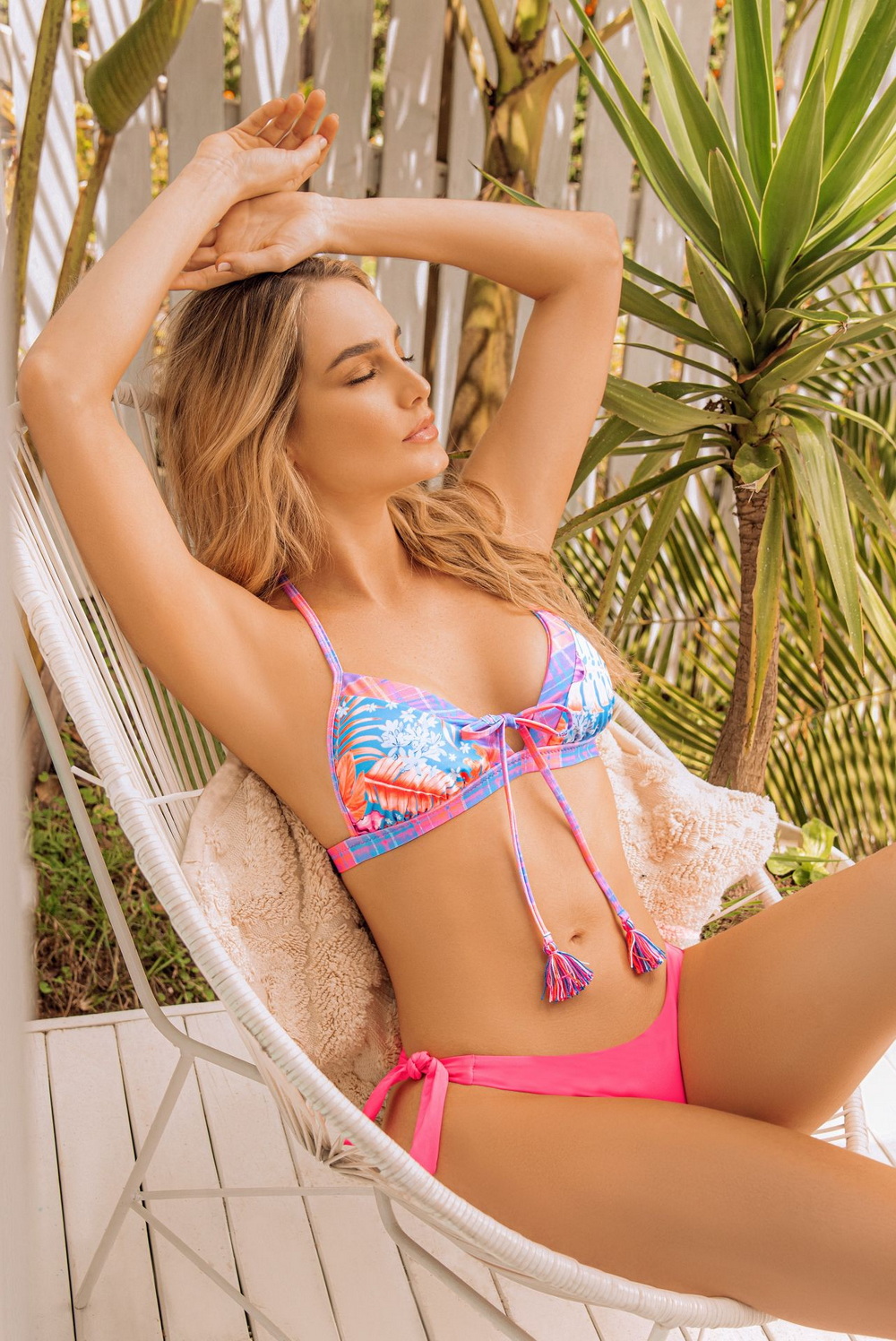
Sustainability in the Swimwear Industry
The swimwear industry is increasingly prioritizing sustainability, with many brands adopting eco-friendly practices. This shift is driven by consumer demand for environmentally responsible products. Brands like Vitamin A and Wolven are leading the way by using recycled materials and sustainable fabrics in their collections.
Sustainable swimwear not only reduces environmental impact but also appeals to a growing segment of eco-conscious consumers. As the industry continues to evolve, we can expect more brands to embrace sustainable practices, making eco-friendly swimwear a norm rather than an exception.

The Global Swimwear Market: A Growing Opportunity for Vendors
The swimwear market has been experiencing steady growth, presenting lucrative opportunities for swimsuit vendors across the globe. According to recent market research, the global swimwear market was valued at USD 21.10 billion in 2024 and is projected to reach USD 26.13 billion by 2031, exhibiting a compound annual growth rate (CAGR) of 3.1%. This growth trajectory underscores the potential for swimsuit vendors to expand their operations and capture a larger market share.
Several factors contribute to this positive trend in the swimwear industry. The increasing popularity of beach vacations, the rise of swimming as a recreational activity, and the growing awareness of the importance of sun protection have all played a role in driving demand for swimwear. Additionally, the fashion industry's influence has transformed swimwear from mere functional attire to a style statement, further fueling market growth.
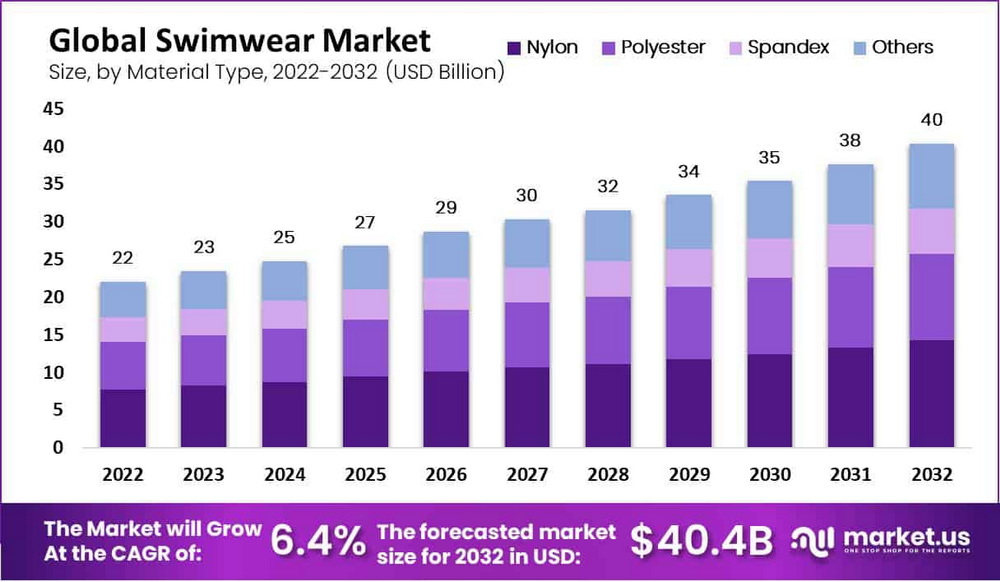
Fabrics Used in Swimsuits
When it comes to swimsuits, the fabrics they are made from play a big role in how they look and feel. Different swimsuit materials are chosen for specific reasons. Let's dive into the common types of fabrics and why they matter so much!
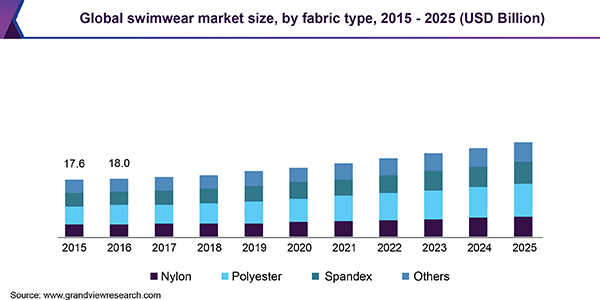
Types of Swimwear Fabrics
The choice of fabric is crucial in swimwear design, affecting both performance and comfort. The most common types of swimwear fabric include:
◆ Spandex (Elastane): Known for its exceptional stretch and recovery, spandex is often blended with other materials to enhance flexibility and comfort. It is the most widely used fabric in swimwear due to its ability to retain shape and resist fading.
◆ Polyester: This fabric is known for its durability and resistance to chlorine, making it ideal for competitive swimwear. Polyester blends with spandex offer a balance of stretch and strength.
◆ Nylon: Lightweight and quick-drying, nylon is another popular choice for swimwear. It provides a sleek fit and is often used in both casual and performance swimwear.
◆ Neoprene: This thicker material is often used in wetsuits and fashion swimwear, providing insulation and a unique aesthetic.
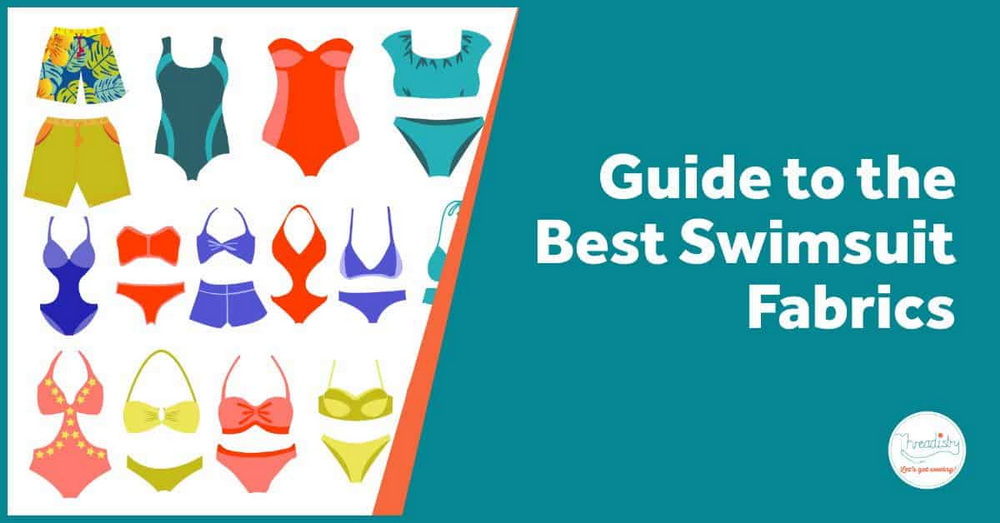
Common Swimsuit Fabrics
Swimsuits are usually made from a few main types of fabrics. The most popular ones include spandex, nylon, and polyester. Spandex is stretchy, which helps the swimsuit fit snugly on your body. This makes it comfortable to wear while swimming and playing. Nylon is another common fabric. It is strong and dries quickly, making it great for water activities. Lastly, polyester is durable and holds its shape well, even after many swims. These three fabrics work together to create comfortable swimsuits that can last a long time.
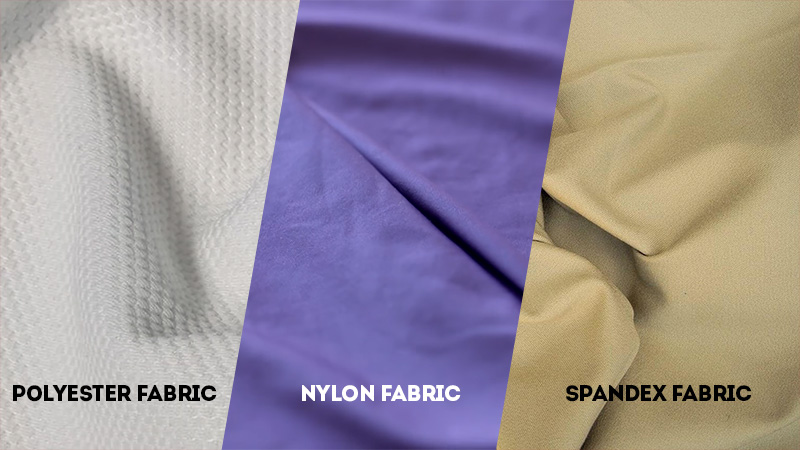
Why Fabric Choice Matters
The choice of fabric is important for a few reasons. First, the right fabric can make a swimsuit feel comfortable to wear. No one wants a swimsuit that feels itchy or too tight. Second, it affects how long the swimsuit will last. Fabrics like nylon and polyester are better at resisting wear and tear. Lastly, the fabric helps with performance in the water. For example, some swimsuits are made from materials that help you move better while swimming. This means that what a swimsuit is made of can change how fun it is to be in the water!
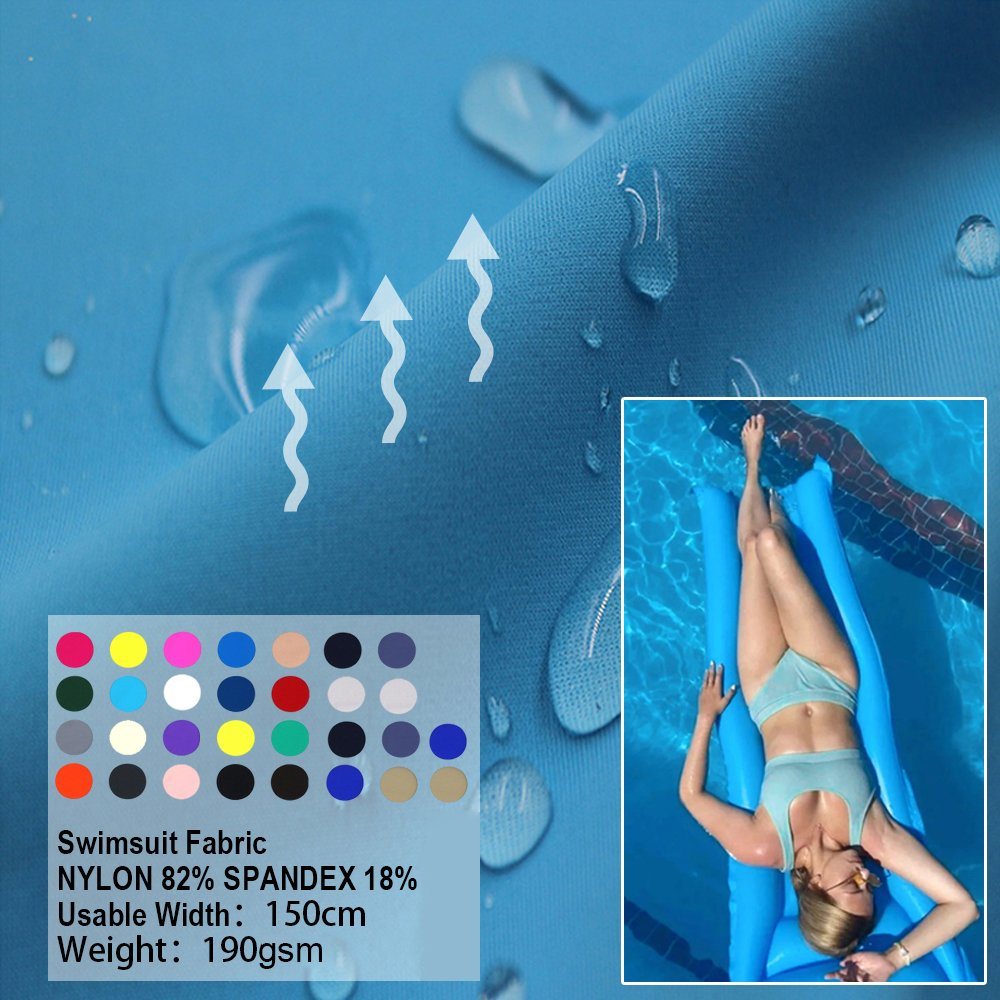
The Crucial Role of Swimwear Fabric in Product Development
For swimsuit vendors, understanding the importance of swimwear fabric is crucial to success in the market. The choice of fabric can make or break a swimwear collection, affecting everything from comfort and durability to style and performance. Let's explore the key aspects of swimwear fabric that vendors must consider:
Performance and Durability
Swimwear fabric must withstand harsh conditions, including exposure to chlorine, saltwater, and UV rays. High-quality swimwear fabric is designed to resist fading, stretching, and degradation, ensuring that the swimsuits maintain their shape and color even after repeated use. Swimsuit vendors must carefully select fabrics that offer optimal performance and longevity to meet consumer expectations and build brand loyalty.
Comfort and Fit
The comfort of a swimsuit is largely determined by the swimwear fabric used. Fabrics that offer stretch and recovery properties, such as those containing elastane or spandex, are essential for creating swimwear that moves with the body and retains its shape. Swimsuit vendors must consider the balance between compression and flexibility when choosing swimwear fabric to ensure a comfortable and flattering fit for their customers.
Moisture Management and Quick-Drying Properties
Effective moisture management is a critical feature of quality swimwear fabric. Fabrics that wick moisture away from the skin and dry quickly not only enhance comfort but also prevent the growth of bacteria and odors. Swimsuit vendors should prioritize swimwear fabrics with these properties to meet the demands of discerning consumers.
UV Protection
With increasing awareness of the dangers of sun exposure, swimwear fabric with built-in UV protection has become a sought-after feature. Swimsuit vendors can differentiate their products by offering swimwear made from fabrics with UPF (Ultraviolet Protection Factor) ratings, providing an added layer of sun protection for their customers.
Sustainability and Eco-Friendly Options
As environmental concerns continue to shape consumer preferences, swimsuit vendors are increasingly turning to sustainable swimwear fabrics. Recycled polyester, organic cotton, and innovative eco-friendly materials are gaining traction in the swimwear industry. Vendors who incorporate these sustainable swimwear fabrics into their collections can appeal to environmentally conscious consumers and contribute to a more sustainable fashion ecosystem.
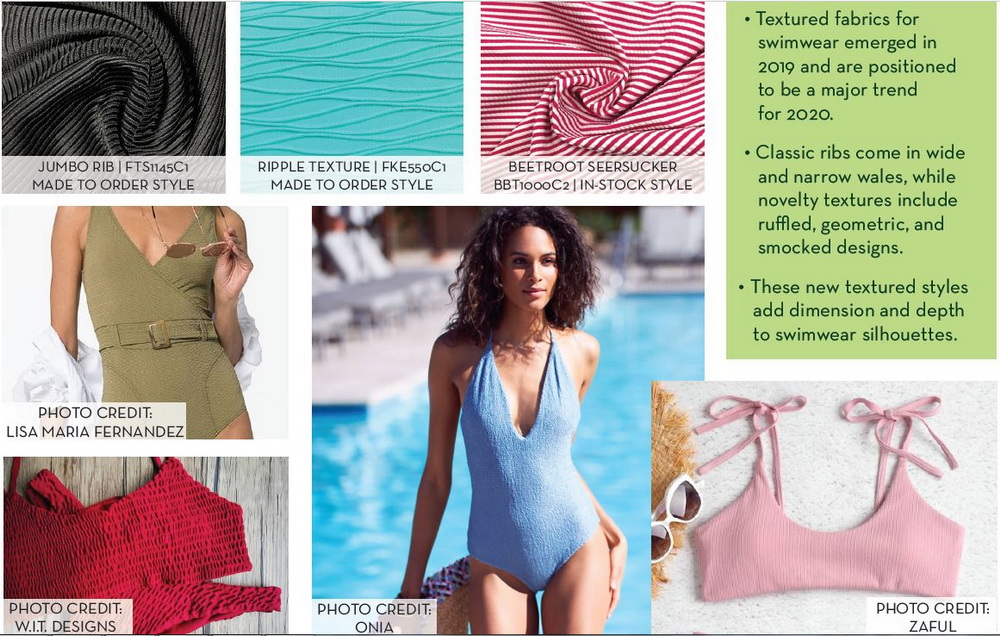
Trends Shaping the Swimwear Fabric Landscape
Swimsuit vendors must stay abreast of the latest trends in swimwear fabric to remain competitive in the market. Some of the key trends influencing the swimwear fabric industry include:
Textured Fabrics
The upcoming seasons are set to see a rise in textured swimwear fabrics. Ripple textures and classic rib styles are making a comeback, adding visual interest and tactile appeal to swimwear designs [1]. Swimsuit vendors can capitalize on this trend by incorporating these textured swimwear fabrics into their collections, offering consumers unique and fashionable options.
High-Tech Performance Fabrics
Advancements in textile technology have led to the development of high-performance swimwear fabrics that offer enhanced functionality. These fabrics may include features such as improved chlorine resistance, increased breathability, or even temperature-regulating properties. Swimsuit vendors who embrace these innovative swimwear fabrics can cater to the needs of serious swimmers and athletes, expanding their market reach.
Luxurious and Glamorous Fabrics
For swimsuit vendors targeting the high-end market, luxurious swimwear fabrics are gaining popularity. Fabrics with a silky feel, metallic finishes, or intricate patterns can elevate swimwear designs and appeal to consumers looking for premium products. By incorporating these opulent swimwear fabrics, vendors can create collections that stand out in the luxury swimwear segment.
Eco-Conscious Materials
As mentioned earlier, sustainable swimwear fabrics are becoming increasingly important in the industry. Swimsuit vendors who prioritize eco-friendly materials in their collections can tap into the growing market of environmentally conscious consumers. From recycled nylon to organic hemp, the options for sustainable swimwear fabrics are expanding, offering vendors more choices to create eco-friendly swimwear lines.
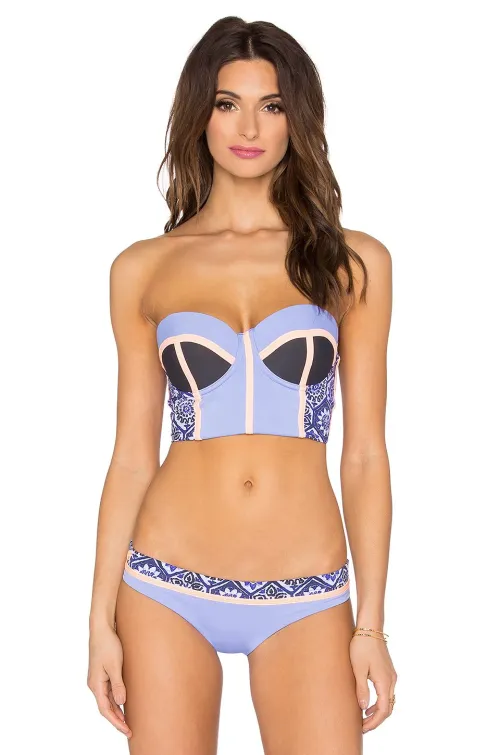
Challenges Faced by Swimsuit Vendors in Fabric Selection
While the swimwear market presents numerous opportunities, swimsuit vendors face several challenges when it comes to selecting and sourcing swimwear fabric:
Balancing Cost and Quality
High-quality swimwear fabric often comes at a premium price, which can impact profit margins for swimsuit vendors. Striking the right balance between fabric quality and cost is crucial for maintaining competitiveness in the market while ensuring customer satisfaction.
Meeting Diverse Consumer Preferences
With a wide range of consumer preferences in terms of style, functionality, and sustainability, swimsuit vendors must carefully curate their swimwear fabric selections to cater to different market segments. This requires a deep understanding of target demographics and their specific needs.
Navigating Supply Chain Complexities
Sourcing high-quality swimwear fabric can be challenging, especially for smaller vendors. Establishing reliable relationships with fabric suppliers and manufacturers is essential for ensuring a consistent supply of quality materials.
Keeping Up with Technological Advancements
The rapid pace of innovation in swimwear fabric technology means that vendors must continuously educate themselves and adapt their product offerings to incorporate the latest advancements in fabric performance and sustainability.
Swimsuit Market Dynamics
The swimsuit market is always changing. Understanding the market dynamics helps us see how swimsuits are made, sold, and what makes them popular. The swimsuit industry is influenced by many factors, such as seasons, styles, and even different cultures around the world. Let's take a closer look at these ideas.
Seasonal Demand
Swimsuits are especially popular during warm months, like summer. People want to go to the beach or pool, and they need new swimsuits for those fun activities. This is called seasonal demand. Vendors often prepare for this by creating catchy advertisements and having big sales when the weather gets warm. In colder seasons, like winter, swimsuits might not sell as well. This is why swimsuit vendors need to get ready for busy seasons by having enough stock and trendy styles.
Global Influences
Different countries and cultures have their own styles when it comes to swimsuits. For example, in some parts of the world, people prefer bright colors and fun patterns. In other places, swimsuits may be more classic and simple. These market trends can change how swimsuits look and feel. Vendors pay close attention to these global influences so they can offer styles that everyone will love. This makes the swimsuit industry exciting and diverse!
Innovative Swimsuit Designs
The world of swimsuits is always changing, and one exciting part of that change is the swimsuit designs. Today, many creative and fun ideas make swimsuits not just stylish but also useful. Let's dive into some of the coolest new trends in swimsuit designs!
Eco-Friendly Swimsuits
One big trend is the rise of eco-friendly swimsuits. These swimsuits are made from recycled materials, like plastic bottles or old fishing nets. This helps keep our oceans clean! It's made a difference because people want to wear swimsuits that are good for the planet. When you choose an eco-friendly swimsuit, you are not just looking great at the beach; you are also helping Mother Nature!
Tech-Enhanced Swimsuits
Another exciting part of innovative features in swimsuits is tech-enhanced designs. Some swimsuits now come with special features like UV protection. This means they can help protect your skin from the sun while you're swimming. Others dry quickly, so you can jump in and out of the water without feeling soggy. These technical advancements make swimming even more fun and safe!
With all these new and creative swimsuit designs, there's something for everyone. Whether you care about the environment or want the latest tech, the swimsuit world has exciting options for you!
Strategies for Success in the Competitive Swimwear Market
To thrive in the competitive swimwear industry, swimsuit vendors can employ several strategies:
Invest in Research and Development
By staying at the forefront of swimwear fabric innovation, vendors can differentiate their products and offer unique value propositions to consumers. Collaborating with fabric manufacturers and textile research institutions can provide valuable insights into emerging swimwear fabric technologies.
Embrace Customization and Personalization
Offering customizable swimwear options, including fabric choices, can help vendors cater to individual consumer preferences and create a more personalized shopping experience.
Focus on Sustainability
As eco-consciousness continues to grow, swimsuit vendors who prioritize sustainable swimwear fabrics and transparent supply chains can build strong brand loyalty among environmentally aware consumers.
Leverage Digital Technologies
Utilizing 3D modeling and virtual try-on technologies can help vendors showcase their swimwear fabrics and designs more effectively, enhancing the online shopping experience for consumers.
Collaborate with Influencers and Athletes
Partnering with influencers and athletes to promote swimwear collections can help vendors reach wider audiences and demonstrate the performance capabilities of their swimwear fabrics in real-world settings.
The Future of Swimwear Fabric and Market Projections
Looking ahead, the swimwear market is poised for continued growth, with projections indicating a market value of USD 26.13 billion by 2031. This growth will likely be driven by several factors, including:
Technological Advancements in Swimwear Fabric
Ongoing research and development in textile technology will lead to even more innovative swimwear fabrics, offering enhanced performance, comfort, and sustainability features.
Increasing Focus on Sustainability
The demand for eco-friendly swimwear is expected to grow, pushing swimsuit vendors to adopt more sustainable practices and materials in their production processes.
Expansion of Athleisure and Multifunctional Swimwear
The blurring lines between activewear and swimwear will create opportunities for vendors to develop versatile swimwear fabrics that cater to various activities beyond swimming.
Growing Emphasis on Inclusive Sizing and Designs
As body positivity movements gain momentum, swimsuit vendors will need to adapt their fabric choices and designs to cater to a more diverse range of body types and sizes.
Rise of Direct-to-Consumer (DTC) Models
The increasing popularity of DTC business models will allow smaller swimsuit vendors to enter the market and compete with established brands by offering unique swimwear fabric options and personalized experiences.
Introduction to Swimsuit Vendors
What Are Swimsuit Vendors?
So, what exactly are swimsuit vendors? Well, swimsuit vendors are the brands and stores that sell swimsuits. They come up with different designs and styles to make sure everyone can find something they like. Whether it's a cool bikini or a comfy one-piece, swimsuit vendors think about what people want to wear at the beach or pool.
Why Is This Topic Important?
Learning about swimsuit vendors is important because they influence what we wear during hot summer days. The choices they make can help us feel good about ourselves when we go swimming. Plus, understanding the trends in swimsuits can also show us how fashion changes over time. It's interesting to see how something as simple as a swimsuit can be a reflection of our culture and style!
Market Analysis of Swimwear Vendors
The global swimwear market is projected to grow from approximately $20.47 billion in 2023 to $30.59 billion by 2032, with a compound annual growth rate (CAGR) of 4.68% during the forecast period. Factors contributing to this growth include the increasing popularity of swimming as a recreational activity, the rise of beach tourism, and the growing interest in water sports.

The market is dominated by several key players, including Speedo, Nike, Adidas, and Zara, which have established themselves as leaders in the swimwear segment. These brands are known for their innovative designs and high-quality materials, catering to a diverse range of consumers from competitive swimmers to casual beachgoers.
Top Brands in the Swimwear Market
◆ Speedo: Renowned for its performance swimwear, Speedo is a favorite among competitive swimmers. The brand focuses on high-tech fabrics that enhance speed and comfort.
◆ Nike Swim: Nike offers a range of swimwear that combines style with functionality, appealing to both athletes and casual swimmers.
◆ Adidas: Known for its sporty aesthetic, Adidas swimwear is designed for both performance and leisure, making it a popular choice for active individuals.
◆ Summersalt: This brand has gained popularity for its stylish and size-inclusive swimwear, emphasizing comfort and fit.
◆ Quince: Recognized for its sustainable practices, Quince offers high-quality swimwear made from eco-friendly materials.
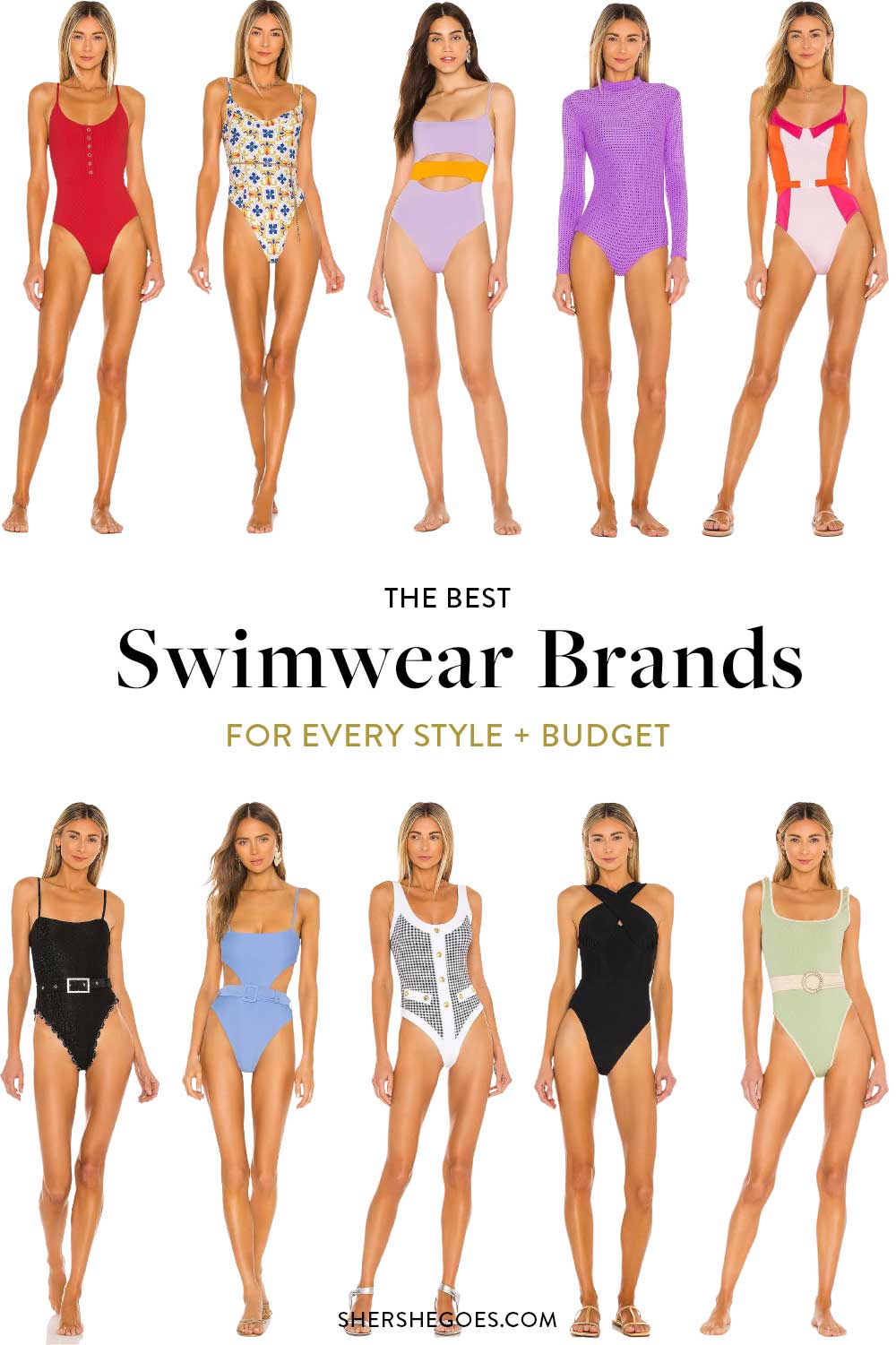
Conclusion
As we explored the fascinating world of swimsuit vendors, we learned that the swimsuit industry is always changing. From the trends in swimsuit fashion to the types of fabrics used in making comfortable swimsuits, there are many important aspects to consider.
Understanding the market dynamics helps us see why swimsuits are popular during certain seasons and how different cultures influence designs. Additionally, the innovative swimsuit designs we discussed show how creativity and technology are shaping the future of swimwear, making it not only stylish but also sustainable and functional.
By keeping up with these trends and innovations, we can appreciate how swimsuits are more than just clothing; they reflect our changing lifestyles and values. So, whether you're heading to the beach or the pool, knowing about swimsuit vendors and what they offer can help you choose the best swimwear for every occasion.
As we look to the future, it's clear that swimwear fabric will continue to be a key differentiator in the market. Swimsuit vendors who prioritize innovation, sustainability, and customer-centric approaches in their fabric selection and product development processes will be well-equipped to navigate the challenges and capitalize on the opportunities that lie ahead in the ever-evolving swimwear landscape.
Frequently Asked Questions (FAQs)
Why do swimsuit styles change?
Swimsuit styles change for many reasons. First, people always want to look fresh and stylish. Designers pay attention to what's popular in fashion and what celebrities are wearing. Sometimes, new materials and technologies also inspire different designs. As people's preferences change, swimsuit vendors adapt to keep up with the latest trends. This way, everyone can find a swimsuit that makes them feel good and confident while enjoying the beach or pool!
What makes a good swimsuit fabric?
A good swimsuit fabric should be soft, stretchy, and durable. Common materials like spandex, nylon, and polyester are popular because they fit well and dry quickly. These fabrics also help keep colors bright and can resist fading from the sun and chlorine. It's important for swimsuit fabrics to be comfortable, so you can swim and play without feeling restricted. When a swimsuit is made from the right materials, it makes your time in the water much more enjoyable!
How do swimsuit designers decide on new trends?
Swimsuit designers look at many things to create new styles. They watch what's happening in fashion, listen to customer feedback, and explore new fabrics and technologies. They also consider cultural influences from different countries, which can inspire unique designs. Designers often attend fashion shows and look at what celebrities are wearing to get ideas. By combining all these sources of inspiration, they create fresh swimsuit designs that everyone will love!










































































